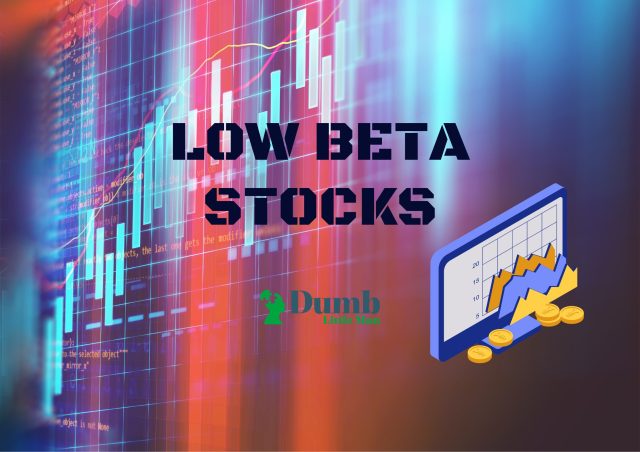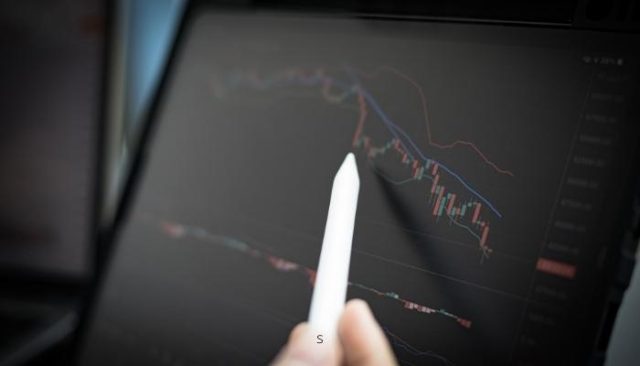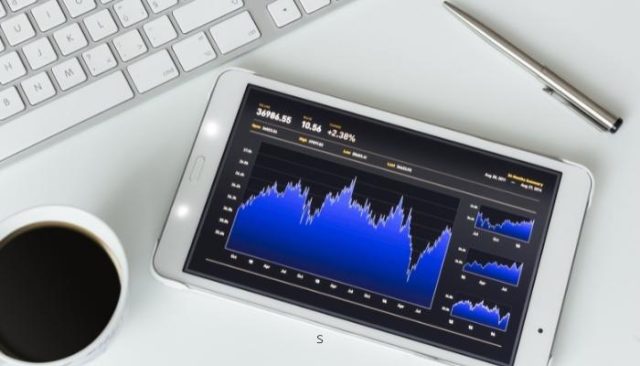Top 6 Low Beta Stocks in 2025
By Wilbert S
January 5, 2025 • Fact checked by Dumb Little Man

Want to jump straight to the answer? The best forex brokers for traders are Avatrade and FXCC
The #1 Forex Trading Course is Asia Forex Mentor
You may know about the stock market and how unpredictable it is. The stock market is full of highs and lows, and it can be difficult to know when to buy or sell. The stock price can go up at one moment, and at the very next moment, it can hit an all-time low. You need to analyze the market properly and make the right decisions, but the question is, how can you do it?
Well, as an investor, you need to assess the risks in a certain stock and it is pretty hard. Evaluating it and making the right decision can make it even tougher. However, one metric that can help you understand the market a bit better and make more informed decisions is beta. Beta is an indicator used to indicate a stock’s risk profile. It comes with some limits but can still be used to understand the market and make better investment decisions.
To understand the low beta stocks, we have got Ezekiel Chew, a founder, and CEO of Asia Forex Mentor, to share his take on Low Beta Stocks. He is also one of the most well-reputed forex traders in Asia and has years of experience in the field. Let’s hear him out.
What is Low Beta Stock

A low beta stock is a stock that has a lower price risk profile as compared to the market. In other words, it is less volatile than the market. Beta is a measure of volatility, and a low beta stock means that the price movements are not as drastic as the market.
Beta is one of the most crucial factors in assessing stock risks. It is a statistical measure used to calculate a stock’s volatility. Beta measures how much a stock price fluctuates in the market. A stock with a beta greater than 1.0 swings more than the market over the same period. A stock’s beta is less than 1.0 if it moves less than the market. High-beta stocks are supposed to be riskier, but they have better risk-adjusted returns; low-beta stocks pose less risk and offer lower returns.
The capital asset pricing model (CAPM) is a beta-based model used to calculate an investment’s expected return. The rate of return that shareholders may reasonably anticipate based on perceived investment risk is determined by the total average market return and the stock’s beta value using the CAPM formula. The CAPM considers the risk-free rate, the market risk premium, and the investment’s beta.
Top 6 Low Beta Stocks
#1. Walmart

Walmart is one of the world’s largest retailers, with over 10,500 stores in 24 countries. It is our go-to place for groceries, home goods, and even clothes. As the pandemic is still raging on, not everyone prefers to go out and think of storing groceries and other essentials, and that’s why Walmart has a lower volatility rate.
To put it another way, Walmart has a beta of 0.43 at the moment, implying a relatively loose connection with the S&P 500. The stock will not be significantly affected by the change in the S&P 500. However, the eCommerce section of Walmart has been on a tear lately.
The company’s online sales have increased 97% in the most recent quarter, and they have also raised $3.6 billion for their eCommerce growth for Flipkart — A Walmart-owned brand. Walmart is spread in several states, and the supplies and customers are abundant. That’s why this company has low beta stock.
#2. Quest Diagnostics (DGS)

The Healthcare sector never sleeps as people need healthcare facilities anywhere, anytime. The treatment of several diseases is not cheap, so Quest Diagnostics is on our list.
This company is generating over 9 billion dollars per year. The company has been in the industry for quite some time and has been generating profits at a fast pace. Quest diagnostics has a competitive advantage because it has a huge market. As a result, the company predicts that revenue will increase at a 2 percent to 3 percent yearly rate. The firm’s 5-year beta score is 0.23 at this time.
The healthcare sector will not end anytime soon. With an increase in the number of people falling sick every day, this company’s stocks might rise in the future. So, you can consider Quest Diagnostics as one of your options in low beta stocks.
#3. McDonald’s (MCD)

Fast food companies have seen an upsurge worldwide, which has resulted in the fast-food industry having some of the highest dividend yields. Although you may wonder how the capital earns such large dividends, it is because the fast-food industry has some of the greatest yield rates in all sectors. The MCD stock’s beta score is 0.62, with a dividend yield of 2.11%.
The fast-food brands have witnessed an outburst as they can just call and deliver the food immediately. This is why McDonald’s has been able to achieve such success. The company’s digital offerings, as well as the logistics system, are functioning smoothly. Because of client contentment, McDonald’s sales figures are increasing.
Another advantage of their success is that they always come up with new ideas. McDonald’s is constantly updating menus and opening new eateries across the world. As a result, their clients are never weary of them. According to market data, the firm has a cash flow visibility of $8.4 billion, which might be enough to keep paying dividends for the next decade or more.
#4. AstraZeneca (AZN)

The beta score of the AZN individual stocks is the lowest on the list at 0.24. You shouldn’t hesitate to add this low-volatility stock to your account. Besides that, it has a 0.246% dividend yield. So, what is stopping you from investing in AZN?
AstraZeneca is a British-Swedish multinational pharmaceutical and biopharmaceutical company. The reason behind their growth is COVID-19 vaccine development, which has earned a big name like other giants like Pfizer and Moderna. Their vaccine is not just easy to store but also very effective.
Aside from this, the firm is currently developing a large number of next-generation medicines. With over 22 candidates in phase 3, they are confident that everything will go smoothly in the next phase. AstraZeneca’s worldwide appeal has benefited as a result of the Covid vaccine. Moreover, their cash flow for the last quarter is $1.9 billion, so they can spend on their development and future research.
#5. Clorox

COVID-19 boosted many companies, and one of them is Clorox. It is one of the most reliable companies as it has been around for over a century. The company has weathered many storms, and that’s why it is still standing strong.
During the pandemic, Clorox’s wipes and sanitizers were in great demand, and the company could meet that demand. The company has a 0.34 beta score, and its dividend yield is 2.5%. Clorox’s dividend Sharpe ratio is 66%, so there is still room for improvement. Clorox sales increased by double digits in the last quarter.
The reason for this upsurge is that the wipes and sanitizers of Clorox are in great demand as people want to keep their homes and workplaces clean. Moreover, the company has a very strong value of $21.2 billion.
#6. M. Smucker

M. Smucker is a packaged food company with a long list of branded products like Folgers, Dunkin’ Donuts, and Jif. With a beta score of 0.33, it is one of the low-volatility stocks you can invest in.
The company has increased its market value to $12 billion. But what is the reason behind the low stock beta score? M. Smucker has a very diversified portfolio that helps it to reduce the overall risk. The products of M. Smucker are always in demand as people can’t live without food.
At this time, they have a quite good dividend yield of 3.3%. So, there is still potential for growth in the future.
How to Calculate Low Beta Stocks

One of the most crucial factors in trading is volatility, and when the broader market falls, the volatile stocks witness a major price swing. The higher the volatility is, the more risky your portfolio will be. However, by calculating stock volatility, you can easily calculate beta.
But, how to calculate beta stock? Well, it is pretty simple, you can calculate the portfolio price against a certain benchmark measured by the S&P 500. A 1.0 beta implies that the capital will move equally with S&P 500. It depicts that the company’s capital will be highly volatile and will witness price movement.
On the other hand, a stock with a 2.0 beta will move twice as much as S&P 500. A beta of 0 indicates no relationship between the capital and the S&P 500 and implies that the value change in the capital has no impact. A negative correlation between the stock market and the S&P 500 is indicated by a beta of -1.0.
Beta and the Capital Asset Pricing Model

The Capital Asset Pricing Model is a very important model used in the investment world. It tells us about the relationship between an asset’s expected return and risk. This model is used to calculate the optimal portfolio that individual investors should hold.
CAPM and beta go hand-in-hand as beta is used in the CAPM formula to calculate the expected return of a capital and asset risk. Without its use, risky assets would appear to be favorable without it. As a result, investors will buy the best stocks without realizing their drawbacks.
The capital asset pricing model is not always accurate. However, it is still a very useful tool in the investment world to compare and contrast 2 alternatives. You can get a good idea of the risks and rewards of each investment.
Why do Traders use Beta in the Overall Market

As a trader, you always want to be aware of the risks associated with your investments. Beta is a very important tool that can help you do that. It measures the volatility of a stock or an asset and can be very helpful to manage your trading accounts.
Moreover, beta can also help you find new market opportunities. By analyzing a stock’s beta, you can easily determine whether it is undervalued or overvalued. If capital has a high beta, it is more volatile and, therefore, is more likely to be undervalued.
On the other hand, if a stock has a low beta, it is less volatile and, therefore, more likely to be overvalued. Using the beta, you can easily find out which stocks are undervalued or overvalued and make your investment decisions accordingly.
Traditionally, it has been believed that lower beta securities outperform in up moves and underperform in market downturns. However, this isn’t entirely true.
Common beta stocks outperformed significantly in an annual period, according to a study comparing the lowest 30 percent of beta scores in the United States to the top 30 percent.
Why should you choose Low Beta Stocks

Beta is a fairly straightforward method to get the overall market risks. There are a few limitations, but still, it is the most viable approach to get the market risk. While a low beta doesn’t necessarily imply that the stock will outperform, it does provide some downside protection.
Low beta stocks are best due to several reasons. Let’s have a look at the reasons why you should choose it.
#1. Stability
The stability of the lowest beta stocks should not be ignored. It is one of the most important aspects which make it different from other volatile stocks. When you are planning to invest in stocks, one thing that should come to your mind is the company’s stability. No one wants to invest in a company that is not stable and might go bankrupt at any time. Beta helps you with this as it provides information about a stock’s volatility.
#2. Less Risk
As we have already mentioned, low beta stocks are less risky. This is because they are not as volatile as other stocks. If you are risk-averse, then investing in low beta stocks is the best option.
#3. Performance
The low beta stocks have outperformed the market in the long run. The main reason behind this is that these stocks are less risky and provide stability to your portfolio. If you are looking for stocks that will provide you with good returns in the long run, you should consider investing in low beta stocks.
#4. Dividends
One of the best things about low beta stocks is that they often pay dividends. This is because these stocks are usually large companies with a lot of cash flow. This means that they can afford to pay dividends to their shareholders.
Disadvantages of Innovative Beta Strategies

In the investment world, beta is king. That’s because most long-term investors and traders use it to make decisions. But you should be aware of some drawbacks associated with the beta before making any decisions.
The first drawback is that beta doesn’t tell you anything about the future. It’s a historical measure that looks back at how a stock has performed in the past. This means that a stock can have a high beta and still underperform in the future.
Smart-beta tactics may appear to be costly and sometimes provide inadequate outcomes. Traditional index funds have a small fee. However, you may face higher expenses and portfolio turnover with smart-beta investments.
Additionally, beta doesn’t take into account the risk-free rate. This is the rate of return that you would earn if you invested in a risk-free asset, such as a government bond. Finally, beta is a linear measure. This means that it doesn’t consider the fact that stocks often have periods of outperformance and underperformance.
Best Forex Trading Course

Asia Forex Mentor is considered one of the best forex trading courses. Banks, investment managers, and retail traders are all trained by them.
Ezekiel Chew is considered one of the world’s best FX traders. He is also a keynote speaker, strategic growth counselor, and the CEO and founder of Asia Forex Mentor, in addition to trading. He also works with companies, raises mutual funds, and forms venture collaborations.
Using our “scientific and quantitative” approach to trading, AFM assists large and small firms and retail traders in increasing their ROI and profitability. So whether you’re a rookie trader trying to make an honest living by trading forex, equities, indexes, or commodities, or mutual fund managers with a large AUM looking to boost your ROI, we’ve covered you.
Its high success rate demonstrates that the work they undertake for individuals and businesses like yours is practical.
| RECOMMENDED TRADING COURSE | REVIEW | VISIT |
|---|---|---|
 | #1 Forex, Crypto and Stocks trading course. Ranked most comprehensive by Investopedia and Best by Benzinga. Free to Try! |  |
Best Forex Brokers
| Broker | Best For | More Details |
|---|---|---|
 |
| securely through Avatrade website |
| Broker | Best For | More Details |
|---|---|---|
| securely through FXCC website |
Conclusion: Low Beta Stocks

As a trader, you must know that the stock market is highly volatile. There are tons of risks involved in trading stocks. However, you can minimize these risks by investing in low beta stocks. They are less volatile than other stocks and have outperformed the market in the long run.
In the stock market, systematic risk is the only thing you can’t predict or do anything about. But, you can take charge of the unsystematic risks by investing in low beta stocks. This way, you can protect your portfolio from any sudden market crash.
So, what are you waiting for? Just pick a low beta score stock and add it to your portfolio today!
Low Beta Stocks FAQs
Is Low beta good for stocks?
Beta indicates the stock volatility, but lower beta means that the stock price is not volatile compared to the market. So, in general, a low beta is good for stocks because the stock prices are less volatile. With a well-managed company and good reputation, such low beta stocks tend to outperform the market in the long term.
Is Buying high beta stocks riskier than low beta stocks?
High betas stocks are more volatile. They provide a superior return on investment than low-stocks, but high-beta investing is riskier. Because they are highly volatile, the price typically drops alongside the market.
Wilbert S
Wilbert is an avid researcher and is deeply passionate about finance and health. When he's not working, he writes research and review articles by doing a thorough analysis on the products based on personal experience, user reviews and feedbacks from forums, quora, reddit, trustpilot amongst others.













